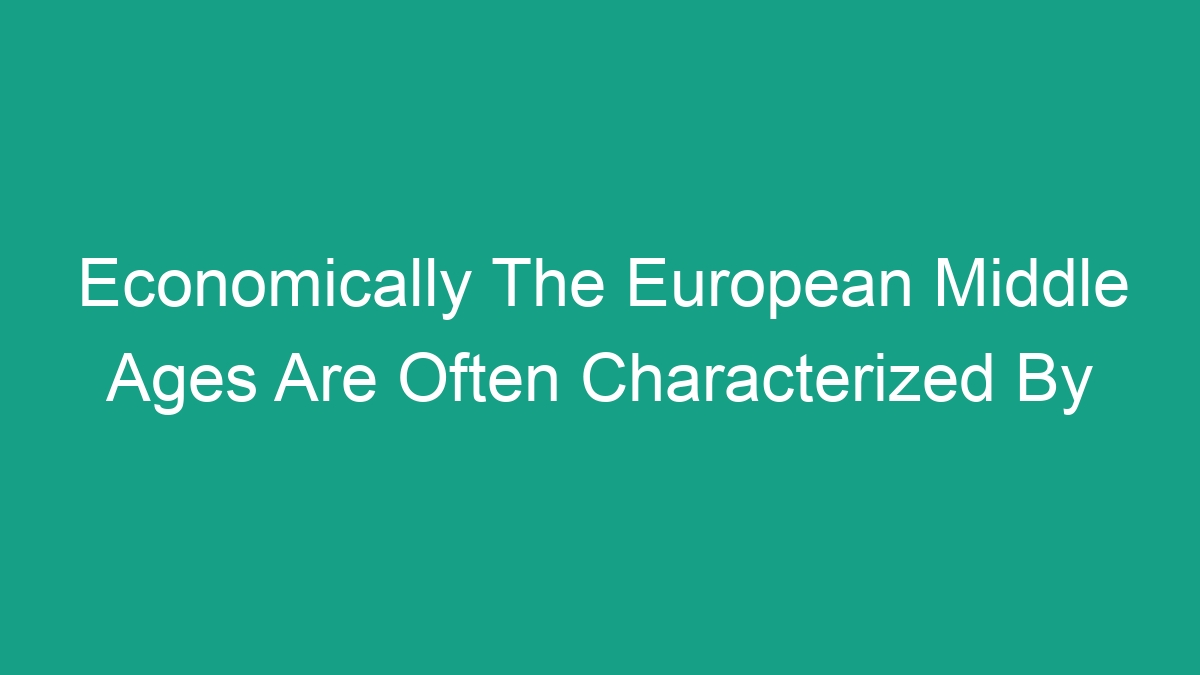
Introduction
The European Middle Ages, also known as the Medieval period, is a significant era in European history that lasted from the 5th to the 15th century. It is often characterized by its unique economic structures and systems. Throughout this period, there were several key economic features that defined the era, including feudalism, manorialism, and the rise of trade and commerce. In this article, we will explore the economic characteristics of the European Middle Ages and their impact on the region’s development.
Feudalism and Manorialism
Feudalism was a dominant social and economic system in Medieval Europe. It was characterized by a hierarchical structure where land was granted by the king to nobles and knights in exchange for military service and loyalty. The nobles, in turn, granted land to peasants, who worked the land and paid taxes in the form of crops or labor. This system was essential in maintaining social order and supporting the military needs of the kingdom.
In tandem with feudalism, manorialism was another crucial economic system during the Middle Ages. Manors were large estates owned by nobles, which included farmland, forests, villages, and the peasants who worked the land. The peasants, also known as serfs, were bound to the manor and required to provide labor and goods to the lord in exchange for protection and the right to work the land.
Agriculture
Agriculture was the primary economic activity during the European Middle Ages. The majority of the population lived in rural areas and were involved in farming. The agricultural techniques of the time were relatively primitive, leading to low productivity and output. The three-field system, where fields were rotated to allow for more effective land use, became widespread during this period and contributed to increased agricultural productivity.
Crops such as wheat, barley, rye, and oats were common staples, while livestock farming, including cattle, sheep, and pigs, was also essential for providing food, clothing, and labor. Agricultural surpluses were crucial for sustaining the population and providing resources for trade and commerce.
Trade and Commerce
While the European Middle Ages are often associated with a predominantly agrarian economy, trade and commerce played a significant role in shaping the economic landscape of the era. With the decline of the Roman Empire, long-distance trade routes became less secure, leading to a shift towards localized trade and exchange.
The development of towns and cities during the Late Middle Ages led to the growth of local markets and fairs, where merchants and craftsmen sold their goods. The increasing demand for luxury goods and the rise of a money economy contributed to the expansion of trade networks within Europe. The Hanseatic League, a commercial and defensive confederation of merchant guilds, played a crucial role in facilitating trade across the region, further stimulating economic growth.
Banking and Finance
During the European Middle Ages, the practice of banking and finance began to emerge. The need for secure methods of transferring wealth and conducting financial transactions led to the development of early banking institutions, such as moneylenders and money changers, who facilitated trade and commerce by providing credit and currency exchange services.
In addition, the Templars and Hospitallers, medieval military orders, acted as financial intermediaries, offering banking and credit services to pilgrims and merchants. Their widespread presence across Europe and the Mediterranean enabled them to establish a system of letters of credit, which facilitated international trade and finance.
Guilds and Craftsmanship
The medieval economy was also characterized by the presence of guilds, which were associations of craftsmen and merchants organized to protect their trade interests and regulate quality standards. Guilds played a vital role in controlling prices, training apprentices, and ensuring fair competition within their respective industries.
Craftsmanship and artisanal production flourished during the Middle Ages, with skilled workers producing a wide range of goods, including textiles, metalwork, ceramics, and glassware. The quality and reputation of these goods contributed to the growth of local and international trade, as well as the development of specialized craft centers in cities such as Venice, Florence, and Bruges.
Conclusion
In conclusion, the European Middle Ages were characterized by a unique and complex economic landscape that encompassed feudalism, manorialism, agriculture, trade, banking, and craftsmanship. These economic systems and activities were essential in shaping the social, political, and cultural development of the region. While the Middle Ages are often overshadowed by the later periods of the Renaissance and Industrial Revolution, it is crucial to recognize the significant contributions of this era to the foundation of modern European economies. Understanding the economic characteristics of the European Middle Ages provides valuable insights into the historical development of the region and its enduring impact on contemporary economic structures.



